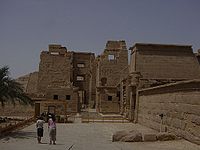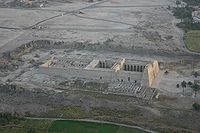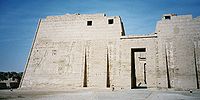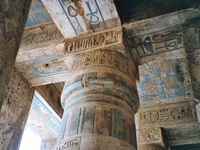
Medinet Habu (location)
Encyclopedia




Thebes, Egypt
Thebes is the Greek name for a city in Ancient Egypt located about 800 km south of the Mediterranean, on the east bank of the river Nile within the modern city of Luxor. The Theban Necropolis is situated nearby on the west bank of the Nile.-History:...
Hills on the West Bank of the River Nile opposite the modern city of Luxor
Luxor
Luxor is a city in Upper Egypt and the capital of Luxor Governorate. The population numbers 487,896 , with an area of approximately . As the site of the Ancient Egyptian city of Thebes, Luxor has frequently been characterized as the "world's greatest open air museum", as the ruins of the temple...
, Egypt
Egypt
Egypt , officially the Arab Republic of Egypt, Arabic: , is a country mainly in North Africa, with the Sinai Peninsula forming a land bridge in Southwest Asia. Egypt is thus a transcontinental country, and a major power in Africa, the Mediterranean Basin, the Middle East and the Muslim world...
. Although other structures are located within the area, the location is today associated almost exclusively (and indeed, most synonymously) with the Mortuary Temple of Ramesses III
Medinet Habu (temple)
Medinet Habu is the name commonly given to the Mortuary Temple of Ramesses III, an important New Kingdom period structure in the location of the same name on the West Bank of Luxor in Egypt...
.
Temple of Amun
Just left of the entrance to the Mortuary Temple of Ramesses III is the Temple of Amun, (Ancient EgyptianDemotic
Demotic may refer to:*Demotic Greek, a variety of the Greek language*Demotic , a script and stage of the Egyptian language...
: Djeser Set) dating to the 18th Dynasty
Eighteenth dynasty of Egypt
The eighteenth dynasty of ancient Egypt is perhaps the best known of all the dynasties of ancient Egypt...
, built by Hatshepsut
Hatshepsut
Hatshepsut also Hatchepsut; meaning Foremost of Noble Ladies;1508–1458 BC) was the fifth pharaoh of the eighteenth dynasty of Ancient Egypt...
and Thutmose III
Thutmose III
Thutmose III was the sixth Pharaoh of the Eighteenth Dynasty. During the first twenty-two years of Thutmose's reign he was co-regent with his stepmother, Hatshepsut, who was named the pharaoh...
. It has undergone many alterations and modifications over the years, partially in the 20th
Twentieth dynasty of Egypt
The Eighteenth, Nineteenth, and Twentieth Dynasties of ancient Egypt are often combined under the group title, New Kingdom. This dynasty is considered to be the last one of the New Kingdom of Egypt, and was followed by the Third Intermediate Period....
, 25th
Twenty-fifth dynasty of Egypt
The twenty-fifth dynasty of Egypt, known as the Nubian Dynasty or the Kushite Empire, was the last dynasty of the Third Intermediate Period of Ancient Egypt....
, 26th
Twenty-sixth dynasty of Egypt
The Twenty-sixth Dynasty of Egypt was the last native dynasty to rule Egypt before the Persian conquest in 525 BC . The Dynasty's reign The Twenty-sixth Dynasty of Egypt (also written Dynasty XXVI or Dynasty 26) was the last native dynasty to rule Egypt before the Persian conquest in 525 BC...
, 29th
Twenty-ninth dynasty of Egypt
Nepherites I founded the Twenty-ninth Dynasty of ancient Egypt by defeating Amyrtaeus in open battle, and later putting him to death at Memphis. Nepherites made his capital at Mendes...
and 30th
Thirtieth dynasty of Egypt
The Thirtieth Dynasty of ancient Egypt followed Nectanebo I's deposition of Nefaarud II, the son of Hakor. This dynasty is often considered part of the Late Period....
Dynasties and the Greco-Roman period.
Temple of Ramesses III
The temple, some 150m long, is of orthodox design, and resembles closely the mortuary temple of Ramesses II (the RamesseumRamesseum
The Ramesseum is the memorial temple of Pharaoh Ramesses II . It is located in the Theban necropolis in Upper Egypt, across the River Nile from the modern city of Luxor...
). It is quite well preserved and surrounded by a massive mudbrick enclosure, which may have been fortified. The original entrance is through a fortified gate-house, known as a migdol (and resembled an Asiatic fortress).
Just inside the enclosure, to the south, are chapels of Amenirdis I
Amenirdis I
Amenirdis I was a God's Wife of Amun in ancient Egypt.She was a Kushite princess, daughter of Pharaoh Kashta and Queen Pebatjma. She is likely to have been the sister of pharaohs Shabaka and Piye. Kashta arranged to have her adopted by the Divine Adoratrice of Amun, Shepenupet I, at Thebes as her...
, Shepenupet II
Shepenupet II
Shepenupet II was an Ancient Egyptian princess of the Twenty-fifth dynasty and the Divine Adoratrice of Amun from around 700 BC to 650 BC. She was the daughter of the first Kushite pharaoh Piye, and sister of Piye's successors Taharqa and Shabaka. She was adopted by her predecessor in office,...
and Nitiqret
Nitiqret Divine Adoratrice
Nitocris I served as the heir to and then the Divine Adoratrice of Amun or God's Wife of Amun for a period of over seventy years, between 655 BC and 585 BC. She was the daughter of the Saite Period twenty-sixth dynasty Egyptian king Psamtik I...
, all of whom had the title of Divine Adoratrice of Amun
Divine Adoratrice of Amun
The Divine Adoratrice of Amun was a second title created for the chief priestess of the ancient Egyptian deity, Amun. During the first millennium BCE, when the holder of this office exercised her largest measure of influence, her position was an important appointment facilitating the transfer of...
.
The first pylon
Pylon (architecture)
Pylon is the Greek term for a monumental gateway of an Egyptian temple It consists of two tapering towers, each surmounted by a cornice, joined by a less elevated section which enclosed the entrance between them. The entrance was generally about half the height of the towers...
leads into an open courtyard, lined with colossal statues of Ramesses III
Ramesses III
Usimare Ramesses III was the second Pharaoh of the Twentieth Dynasty and is considered to be the last great New Kingdom king to wield any substantial authority over Egypt. He was the son of Setnakhte and Queen Tiy-Merenese. Ramesses III is believed to have reigned from March 1186 to April 1155 BCE...
as Osiris
Osiris
Osiris is an Egyptian god, usually identified as the god of the afterlife, the underworld and the dead. He is classically depicted as a green-skinned man with a pharaoh's beard, partially mummy-wrapped at the legs, wearing a distinctive crown with two large ostrich feathers at either side, and...
on one side, and uncarved columns on the other. The second pylon leads into a peristyle hall, again featuring columns of Ramses III. This leads up a ramp that leads (through a columned portico) to the third pylon and then into the large hypostyle hall (which has lost its roof).
In Copt
Copt
The Copts are the native Egyptian Christians , a major ethnoreligious group in Egypt....
ic times, there was a church inside the temple structure, which has since been removed. Some of the carvings in the main wall of the temple have been altered by copt
Copt
The Copts are the native Egyptian Christians , a major ethnoreligious group in Egypt....
ic carvings.
Temple of Ay & Horemheb
Located just north of the Mortuary Temple of Ramesses III, right up to the mud-brick wall that surrounds it, lay the badly preserved Temple of AyAy
Ay was the penultimate Pharaoh of Ancient Egypt's 18th dynasty. He held the throne of Egypt for a brief four-year period , although he was a close advisor to two and perhaps three of the pharaohs who ruled before him and was the power behind the throne during Tutankhamun's reign...
& Horemheb
Horemheb
Horemheb was the last Pharaoh of the 18th Dynasty from either 1319 BC to late 1292 BC, or 1306 to late 1292 BC although he was not related to the preceding royal family and is believed to have been of common birth.Before he became pharaoh, Horemheb was the commander in chief...
.

